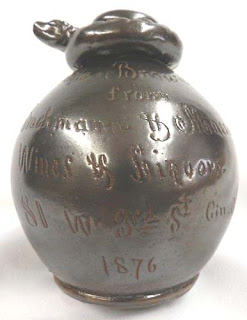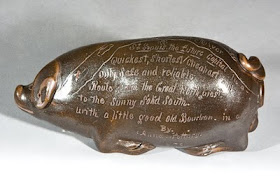







In past posts, readers of this blog have seen my interest in “Art Nouveau,” the artistic movement that took hold in the latter part of the 19th Century in Europe and America that featured organic influenced shapes and sinuous lines. As a result I have long been interested in Alphonse Mucha, a Czech who was one of the leading practitioners of this form. Among his creations were a number of illustrations to merchandise a variety of alcoholic beverages, including champagne, cognac, liqueurs and beer. Through this post I have brought the images of these Mucha creations to one place on the Web. Note too that many Mucha illustration depict bottles.
His Wikipedia biography gives details of the life of Mucha, who died in 1939: "Alphonse Maria Mucha was born in 1860 in the town of Ivanice, Moravia (the present Czech Republic). Although his singing abilities allowed him to continue his education through high school in the Moravian capital of Brno, drawing had been his main hobby since childhood. He worked at decorative painting jobs in Moravia, mostly painting theatrical scenery.
"In 1879 he relocated to Vienna to work for a major Viennese theatrical design company, while informally augmenting his artistic education. When a fire destroyed his employer’s business during 1881 he returned to Moravia to do freelance decorative and portrait painting. Count Karl Khuen of Mikulov hired Mucha to decorate Hruaovany Emmahof Castle with murals and was impressed enough that he agreed to sponsor Mucha’s formal training at the Munich Academy of Fine Arts. “Mucha moved to Paris in 1887 and continued his studies at Academie Julian and Academie Colarossi. In addition to his studies, he worked at producing magazine and advertising illustrations.
"About Christmas 1894 Mucha happened to go into a print shop where there was a sudden and unexpected need for a new advertising poster for a play featuring Sarah Bernhardt, the most famous actress in Paris. Much volunteered to produced a lithographed poster within two weeks and on 1 January 1895 the advertisement for the play was posted in the city where it attracted much attention.
“Mucha produced a flurry of paintings, posters, advertisements and book illustrations, as well as designs for jewelry, carpets, wallpaper and theater sets n ha was termed initially the Mucha Style but became known as Art Nouveau (French for “new art). Mucha’s works frequently featured beautiful young women in flowing, vaguely Neoclassical-looking robes, often surrounded by lush flowers which sometimes formed halos behind their heads. In contrast with contemporary poster makers he used pale pastel colors.
“His Art Nouveau style was often imitated. The Art Nouveau style, however, was one Mucha attempted to disassociate himself from throughout his life; he always insisted that rather than maintaining any fashionable stylistic form, his paintings were entirely a product of himself and Czech art. He declared that art existed only to communicate a spiritual message, and nothing more; hence his frustration at the fame he gained by his commercial art, when he most wanted to concentrate on more artistic projects.”
Mucha’s concerns about his commercial art seem ludicrous in light of the many of his wine and liquor prints that decorate many homes, apartments and college dormitory rooms. They celebrate products, many of which are still sold today. They include Moet & Chandon and Heidsieck champagne, Bisquit Cognac, La Trappestine liqueur, and my favorite, Benedictine. Bieres de al Meuse seems to have dropped off the French brew map long ago, however, while the Mucha poster goes on and on in sales.









